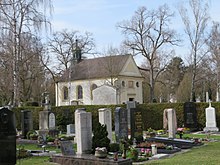Cemetery chapel (Westfriedhof Ingolstadt)
The Friedhofskapelle is a chapel on the listed Westfriedhof in Ingolstadt .
history
The cemetery chapel dates from 1802 and replaced a previous building, the little church of the Holy Cross. This was destroyed by Austrian soldiers in 1800.
The new chapel was donated by the owner of the Schwabenbräu on Theresienstraße , Walburga Geislmayr. A memorial stone inside the chapel commemorates the donor. In the year the chapel was built, Elector Max IV. Joseph issued a ban on burial within the cities, whereupon numerous cemeteries in Ingolstadt had to be closed. In 1803, today's Westfriedhof, which was consecrated as a church in front of the Kreuztor, was opened as a municipal simultaneous cemetery for several denominations and as the only burial place for residents of Ingolstadt. At that time the chapel was still on the edge of the cemetery; its northern long side flanked the road to Gerolfing . It was not until 1925 that the path system of the Westfriedhof, which was expanded several times, was aligned with the chapel, which thus became a central element of the complex.
According to a resolution of the electoral Bavarian government in 1805, the chapel once belonged to the Upper and Lower Parish, who would have been responsible for the maintenance of the building. When the chapel had to be renovated in 1906, this was forgotten and the city of Ingolstadt paid for the work. After it became clear in retrospect that the city would not have been responsible for maintaining the building, the money that had already been spent was declared a one-time grant.
description
Above the entrance on the east side of the simple, plastered building with a small western roof turret is the year 1802 and above it a fresco depicting the purgatory . On this side of the building there are two round windows and two square windows below. The entrance can be reached via two steps.
The chapel's baroque seven refuge altar dates back to 1777 and was probably taken over from the Jesuit church, which no longer exists today. The altar is complemented by a crucifixion and a purgatory image. On the long sides, there are six depictions of the Passion of Christ under three arched windows.
The chapel stands on the oldest part of the Ingolstadt West Cemetery; There are numerous graves of respected Ingolstadt citizens nearby. The priests' graves are located directly on the long southern side of the chapel, while on the northern side three classicist memorial stones commemorate the victims of a murder on March 17, 1800.
Memorial stones for the Melbers family
The memorial stones on the north facade are dedicated to the widowed flour trader ("Melberin") Maria Helena Prandtner and her two daughters Helena (* 1780) and Johanna (* 1787). The middle, slightly higher tombstone bears the heading “For Eternal Memory”; all three stones are inscribed with poems and bear the life data of the buried on the plinth, each ending with the words “Murdered March 17, 1800”. On Helena Prandtner's tombstone, the detailed circumstances of the bloody act are discussed: The murderers would have spared neither blood nor youth nor “other beautiful virtues”, “although they lived in the house”, but they were already standing before the eternal judge. The poem on the middle tombstone, which is dedicated to the mother, supplements this information with the time of the crime: the three murder victims were killed "in the black night". The poem on the tombstone for the younger daughter puts the young age of Johanna Prandtner in the foreground. It starts with the verse
"O woe here lies
defeated by death
In the spring of her years
Johanna in der baahre"
and ends with
"Come here dear angels of god
And bring the
heavenly child Johannen
To remember later,
in heavenly gelanz the martyr laurel wreath
".
The crime occurred during the Napoleonic Wars. At that time the French and the Austrians allied with them were in front of Ingolstadt. The two Bohemian soldiers Theodor Luzian or Luzius and Adam Hoferer had gained the trust of Melberin Prandtner, who was evidently afraid of attacks and was looking for male protection. Helena Maria Prandtner and her daughters lived “Auf der Lachen”, ie on today's Beckerstrasse.
When they were attacked by Luzian / Luzius and Hoferer on March 17, 1800 at around 10 p.m., they defended themselves vigorously, but were overwhelmed and, according to the lawyers who had to deal with the murder, "cruelly beaten".
In the course of the fight, however, one of the two soldiers lost his stick, which led the police on the right track: The two Bohemians were caught and transferred on the basis of their blood-stained clothing. The two were sentenced to death for the murder of the Prandtner family; the execution, to which the poem on the left tombstone alludes, took place on June 9, 1800 at the execution site in front of the bridgehead. Maria Helena Prandtner and her daughters were initially buried in the Sebastianskirche cemetery, but soon afterwards they were reburied in the Westfriedhof.
Web links
Individual evidence
- ↑ a b c d e f g h Josef Würdinger, A walk on the Ingolstädter Westfriedhof (excerpt) , July 2010, especially p. 17 f. and 47 ( digitized version )
- ↑ a b c d Bernhard Pehl, Unknown Church Recalls Mord , in: Donaukurier , March 3, 2006, online at www.donaukurier.de
Coordinates: 48 ° 45 ′ 57 " N , 11 ° 24 ′ 34.1" E



